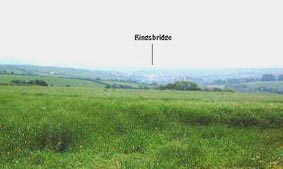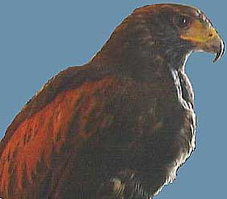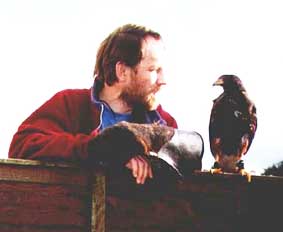SIGI - The Harris Hawk
Steve New
(South Devon, Great Britain)
I live in the small country town of Kingsbridge, in a part of rural South Devon, UK, called The South Hams. A Ham in old English is a steep sided,wooded valley.
We are bordered to the North with the Southern edge of Dartmoor, a wilderness area and to the South by the Sea. A farming area, mostly a Dairy and Arable mixture, there are many opportunities for hunting small game. We are in what is classified as an "Area of Outstanding Natural Beauty" and have many reserves for Birds and other wildlife. While I am also a hunter with guns, and now also Hawks, I have always been first and foremost a naturalist, and never feel happier than when out and about observing all that is going on in the countryside around me.

Since I was about 12 years old I have rescued various Raptors (and other wildlife), and hacked them back to the wild, mostly Kestrels, Buzzards and Owls. Then I went to work with a Wildlife Park and looked after Eagles, Vultures, Eagle Owls, Falcons and Hawks etc.
Until recently I have not had the time or facilities to keep a Falcon or Hawk for long periods, but in September of 1998 I decided to get a bird purely for hunting. Until now I had gone on a refresher course every few years to keep my knowledge up to date.At the moment I have six birds, though only three are flown for hunting.
I have Sigi the subject of this article, also a Red Tail Buzzard, a Common Buzzard, two Barn Owls and a European Eagle Owl My Harris Hawk, Sigi (short for Sigidi, a Zulu war cry), is currently coming to the end of his second moult and this time is "feather perfect". He flies at 1lb 9oz / 700gr. and is VERY fast.
I usually fly him either from the fist or I let him fly ahead in the trees and he strikes whatever I can flush for him. This is usually Rabbits, Pheasants or Pigeon/Doves. He's also expressed a great interest in Canada Geese and Duck, but I haven't had the nerve to try him on them YET. I don't really want to have to swim to get him back. I don't think there is anything that Sigi would not like to try out as quarry, though this can on occasions be dangerous, to him and me! I was going to get a Falcon, but the sort of enclosed, hilly country where I live means I would spend all of my time looking for my bird. Sigi stays fairly close, and I can usually see where he's gone. He also returns to the whistle which is a great help.

One time I saw a movement in some bushes at the side of a Stone Quarry and then saw Sigi, slam into and through a bush. A FOX came out the other side with Sigi attached to its back, it ran low to the slope of the Quarry side, up to the top and over the rim and then through some thorn bushes. I was standing with my mouth open thinking that Sigi would be very lucky indeed to get away with serious injury or being killed, and then ran down the side of the hill to get access to the top of the field that they'd disappeared into.
Out of breath I jumped the fence and ran up the 45 degree slope, breathless and heart pumping hard, calling for Sigi and blowing the whistle, hoping to get some sort of response, as I couldn't see anything because of the thorn bushes all over the side of the hill, nothing could be seen or heard at all.
I climbed the rest of the way up the slope, thinking the worst, when I heard the tinkle of Sigi's bells and turning the corner of the top line of bushes I saw Sigi standing on top of a thorn bush, without a care in the world!!
I whistled to him and he flew over to my fist, I checked him over for the expected blood, holes or other injuries and not a mark on him. I think that luckily, he was brushed off by a bush at the top of the cliff, as they went over the rim of the Quarry. The Fox could easily have killed him if it had thought to turn around to bite him.
This episode brought home to me forcefully how fearless these birds are, and gave me pause for thought about having to watch where we were flying, and what is out and about on the ground. He doesn't really have a preference for quarry although he is prone to having a go at anything that has feathers, trying for hopeless targets like Woodpigeons and Crows in full flight. This has shown some interesting flights , producing high speed wingovers and aerobatics when targets of opportunity like a rabbit appear on the flightline.
One day I came back out of a field at the top of a deep valley that had produced nothing, and cast Sigi into a tree at the border of a small wood. Suddenly he did a vertical wingover at twelve metres high and crashed into some bushes . I watched as a Cock pheasant erupted out of the bush and flew across the track, leaving Sigi on the ground with tail and body feathers in his talons. The Pheasant had just made it into the trees when to my suprise Sigi flew after him into the trees.

This was at the end of a long tiring day and the valley drops down steeply at this point, wooded on the side I was on, and open fields on the other. I didn't really want to have to go down the side of the valley and whistled for Sigi till I was red in the face. I watched the Pheasant do a typical flap and glide flight out of the trees at the valley bottom, followed at three or four metres by Sigi. When they reached the stream at the bottom they then proceeded up the hedge on the other side where the Pheasant put into a thorn bush, near the top of the other side of the Valley. Sigi was only a half second behind the Pheasant and crashed straight in, causing a second eruption of Pheasant.
They flew up to the top of the valley side and then turned right and flew along the hedge line, much to my relief because they would have been out of sight beyond the hedge. They flew straight down the hedge, Sigi only two or three metres behind, flapping all the way. The Pheasant had at this point given up any thought of gliding flight and was pumping his wings for all he was worth. The Pheasant then suddenly did a left turn and plunged into the hedge, with Sigi right behind him. At this point I was totally frustrated because I was so far away, and was concerned about losing Sigi!
I saw the Pheasant leave the other side of the hedge with me thinking NO!!......... I then caught sight of Sigi going into the top of a small tree and he just sat. All of this flight had taken about thirty seconds, though it seemed much longer.
I ran down the side of the hill crashing through the tree to the bottom and whistled and called all the way. When I got through the fence at the bottom and crossed the stream I wave my glove and whistled some more, trying all the while to catch my breath, dreading having to rush up the other side of the valley to find Sigi.
I then heard his bells and realised that he'd heard the whistle and was coming down the hedge through the trees to me, gliding the last hundred metres to my fist.
Afterwards I checked the flight he'd taken after the Pheasant on a map, and the whole flight was around two kilometres!! I'd had a grandstand seat to a magnificent driving flight over the whole flight. It may not have produced a Pheasant for the table but there's not often a chance to follow a flight from start to finish, at least not in a flight at this distance.
From my vantage point on the other side of the valley I could see the whole drama unfolding before me, and it would have been worth paying for! When we get to the place we are going to hunt, I cast Sigi from the fist into the nearest tree and he follows on through the trees as I try to flush something suitable for him to hunt. He usually is forty or fifty metres ahead of me, and moves ahead either to the front or quartering the ground going from side to side.

Sometimes he goes right away from me , high up in the trees on the side of the hill. This gives him a vantage point with a much greater view than I have. This can be worrying as he may see some quarry only a minutes flight away but twenty minutes walking for me, and out of sight! One day I cast Sigi off as usual, and he went up the side of the hill to a hedge and then followed the hedge around the edge of the field. To get to where he was, I had to go along two tracks and it took me ten minutes to get up there. When I got there I whistled for Sigi, but couldn't see any movement at all, though I did hear the tinkle of a bell faintly. I started up the side of the hedge, calling and looking for movement and still couldn't see him, though again I heard a faint bell.
I then just happened to look up and there was Sigi, soaring on a thermal in long lazy circles at one hundred metres. This was the first time he'd ever done this type of flight and I was wondering how to get him down, and if he would come down. From his vantage point he could see about twenty kilometres and I was concerned that he could be a long way from me in minutes. I produced a small tidbit for him and called him down waving my gloved hand. I expected him to come down in a slow spiral, but no, he just folded his wings in tight and dropped straight down at high speed to my upraised glove, spreading his wings at the last second to alight gently on the glove. With a bit of luck I am going to get a female Harris Hawk and try to fly them together in a cast, twice the fun and excitement.
Sigi is really a sociable bird, but NOT an imprint. He calls to me and preens my fingers and hair, but isn't too happy with strangers and that includes my Wife and Children. He's good around my four dogs and just ignores them,but if a strange dog is seen he threatens them. Funny bird. There are many more things to be said about flying a Harris Hawk, this article is just to give a taste of the game.
Sigi, and Harris Hawks in general are highly intelligent, being quick to learn new things and often making new techniques for themselves, adaptable to many different styles of hunting, and will soar and strike like a Falcon when needed, hunt like a Goshawk from the glove, are quick and agile in the trees, fearless when in cover, crashing into any bushes and undergrowth where the prey has gone, with resilient plumage.
They also will try any game if they think they can catch it, making a versatile, all round, non specialist, efficient hunter. Harris Hawks work well with Dogs and Ferrets, will hunt to the lamp at night, and work well with other Harris Hawks when hunted in a cast of two or more. But that's the basis for another article.
* * * * * * * * * * * * * * * * * * * * * * * * * * * *